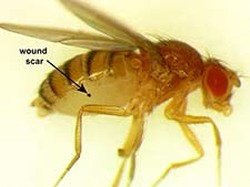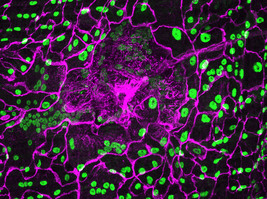Research Summary

Scientists have been working with the fruit fly, Drosophila melanogaster, for more than 100 years to answer fundamental questions in biology. The Losick laboratory takes advantage of the ease and power of Drosophila genetics to understand the basic mechanisms of tissue repair.
Wound healing is not a one-size-fits-all process. While the typical wound healing response relies on cell division to regenerate the cells that are lost by injury, aging, or disease. We found that cells can also be replaced by stimulating existing cells to grow in size by becoming polyploid, a process we have named wound-induced polyploidization (WIP). A polyploid cell is a cell that has more than diploid copy of its chromosomes. As a result, polyploid cells can grow to be many orders of magnitude larger than their diploid cell counterparts. Polyploid cells are ubiquitous in insects and plants, but are also required for the development of many tissues in our body. What remains unknown is why under conditions of stress, like injury, aging, and disease, polyploid cells frequently arise? and how do polyploid cells function during these stress responses?
Wound healing is not a one-size-fits-all process. While the typical wound healing response relies on cell division to regenerate the cells that are lost by injury, aging, or disease. We found that cells can also be replaced by stimulating existing cells to grow in size by becoming polyploid, a process we have named wound-induced polyploidization (WIP). A polyploid cell is a cell that has more than diploid copy of its chromosomes. As a result, polyploid cells can grow to be many orders of magnitude larger than their diploid cell counterparts. Polyploid cells are ubiquitous in insects and plants, but are also required for the development of many tissues in our body. What remains unknown is why under conditions of stress, like injury, aging, and disease, polyploid cells frequently arise? and how do polyploid cells function during these stress responses?

We are beginning to answer these fundamental questions using the fruit fly as a model. Fruit fly puncture wounds (Figure 1) heal by WIP where cells grow in size forming both mono and multi-nucleated enlarged cells (Figure 2). We found that cell enlargement through polyploidization is required for wound healing, since wounds fail to close if WIP is genetically perturbed in Drosophila. In collaborative work, the we recently discovered that WIP also functions in mammals to maintain the size and functional capacity of the repaired tissue by enlarging existing cells in mouse cornea endothelium. Therefore, WIP appears to be a conserved and widely used part of the body’s healing arsenal. The Losick laboratory is currently studying the molecular mechanisms regulating WIP in flies and mice in order to understand how to generate these extra-large cells to improve our bodies ability to heal.